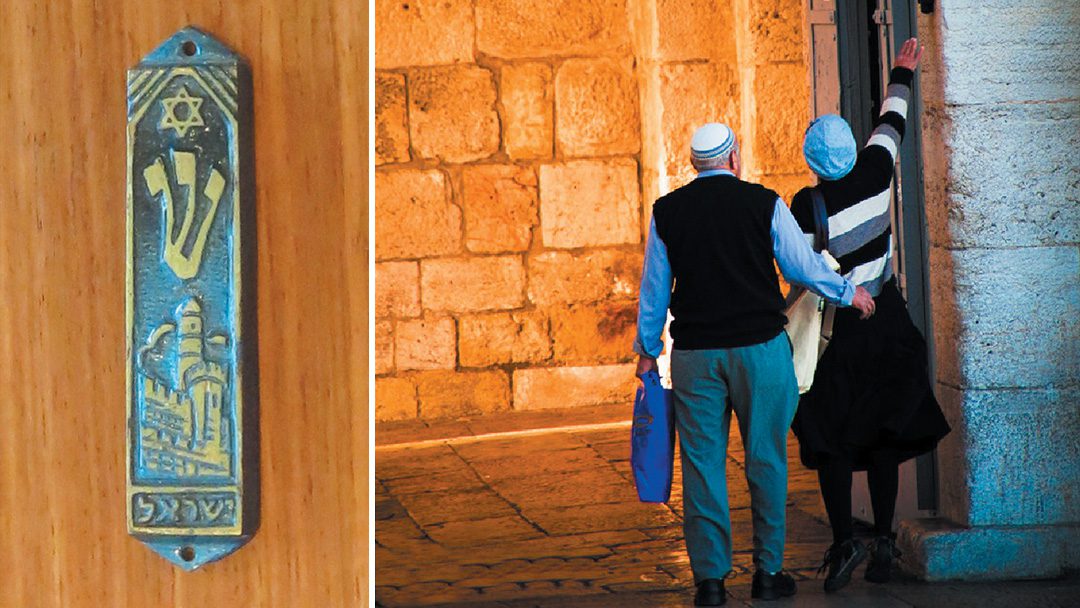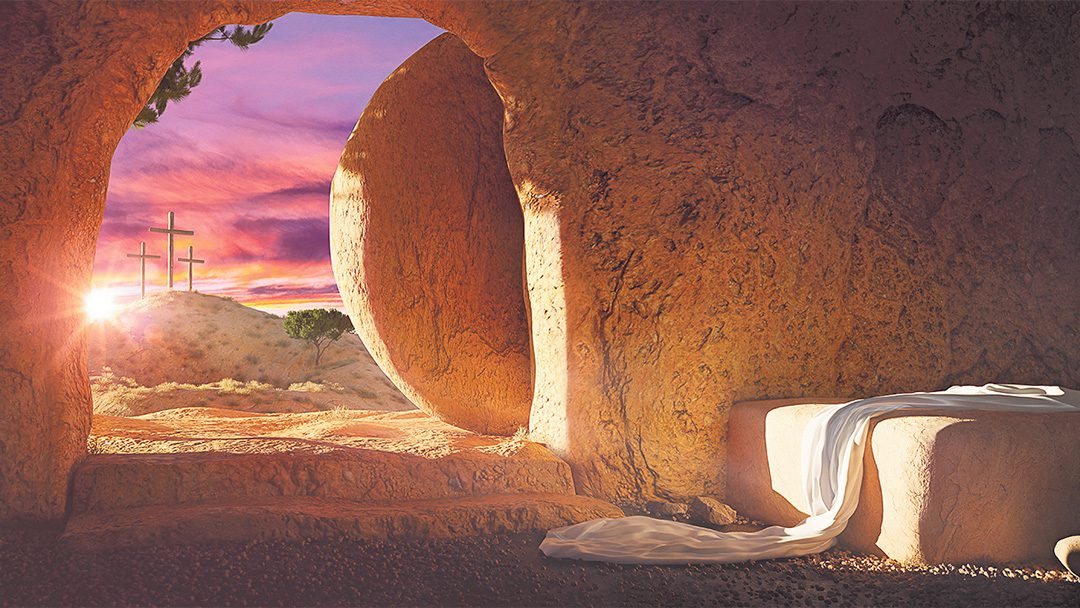When my son bought the house next door, my grandson Eli pointed at the small rectangular box on the doorframe and asked “What’s that grandpa?”
“Oh”, I said, that is a mezuzah. The lady who lived here before you was Jewish and Jewish people attach a mezuzah to the doorframe of their house.’
“Why do they do that?” he asked. “Because the Bible says to.” I said. I anticipated his next question. “What does it do?”
I responded. “I’ll bet that if we were to actually open it up, we would find a tiny scroll with Hebrew writing on it – would you like to take a look?” He nodded excitedly.
So we carefully opened the mezuzah and sure enough, there inside was a tiny scroll with Hebrew writing on it.
To Eli that was like finding the lost ark in a crypt in ancient Egypt. “What does it say?”
“Well”, I said, “why don’t you bring your new mezuzah to Shabbat tonight, and we’ll uncrack the code using a Bible which has both Hebrew and English.”
How the Commandment is Observed
The Jewish people are commanded to write the Torah on the doorposts of their house and gates.
The command looks like this:
And you shall inscribe them upon the doorposts (mezuzot) of your house and upon your gates. Deuteronomy 6:9
The Hebrew word for ‘doorpost‘ is ‘mezuzah’.
After the destruction of the Temple in AD 70, the Sages detailed instructions as to how to observe this commandment by attaching a small case, containing a rolled up scroll of parchment with the words of the ‘Shema’, to the right side of the doorframe of their home, at about shoulder height.
Often, the case displays the Hebrew letter shin on the outside, which stands for Shaddai (often translated as Almighty).
This scroll case with its scroll inside, has become known as a ‘mezuzah’.
What’s Inside the Mezuzah?
Inside each mezuzah is a rectangular piece of parchment called a ‘klaf’, which is made from a specially prepared skin of a Biblically clean (kosher) animal.
The scroll is expertly scribed with Hebrew lettering from the Shema – Deuteronomy 6:4–9 and Deuteronomy 11:13–21.1
Why Have God’s Commands on the Doorposts of One’s Dwelling?
The Sages tell us that there are two realms – our home and the street outside (representing the world). The doorway into the home is a sort of ‘no man’s land’ between the home and the street – where these two realms overlap and interact with each other.
The mezuzah stands at the doorway of the home representing the family’s values and identity giving witness to God, to the world, and to the adversary that this is a home that serves the one true God; a home where the Torah is observed inside.
The home with a mezuzah is ‘a sanctum of holiness and divine presence’.
Whenever a person leaves or enters his home, he sees the mezuzah and is ‘aroused from his mental lethargy and preoccupation with lower matters and reminded of God’s oneness. It makes him realise that nothing is of enduring value except the knowledge of the Almighty – that:
- God is the true Master of his house, while he and his family ‘are merely guests’ and that;
- All his possessions belong to God, who protects him and all his property. 2 3
It is customary for Jewish people to touch the mezuzah with their fingers as they pass in or out
through the doorway of their home (or business) and then touch their lips, like a kiss, showing honour for the Holy Scriptures and a reminder of God’s promise to watch over their comings and goings now and forevermore.
The Mezuzah and Covenant Identity
The presence of a mezuzah on the doorposts of a house signifies a Jewish home where the Torah is observed inside this home.
It says to everyone passing into the house ‘I am Jewish’- ‘I belong to God’.
The mezuzah therefore is a sign of covenant identity, in the same category as circumcision or wearing the tefillin (the little boxes on arm and forehead), or the tzitzit (tassel) on the corner of one’s garment.4
Joshua best describes the intent of the mezuzah:
‘As for me and my household we will serve the Lord.’ Joshua 24:15
To have a mezuzah on the doorframe is a commandment which is still in effect today for all Jewish people no matter where they live in the world.
That is precisely why my Jewish next door neighbour, living on the Gold Coast of Australia – at the far ends of the earth from Jerusalem – had one affixed on her doorframe.
‘On Your Gates’
The last part of the commandment says:
‘And you shall inscribe them … upon your gates’. Deuteronomy 6:9
The nation of Israel took this command seriously, when it installed the world’s largest mezuzah on a wall at Ben Gurion airport in Tel Aviv, Israel – the most prominent gateway into the country.
The gate commandment is also fulilled in the city of Jerusalem. If you’ve ever been to the Old City, you will notice a mezuzah on three of the gates.5
When people walk past they reach up and touch them as a sign of identification.
Gentiles and the Mezuzah
From time to time when I am visiting the homes of certain non-Jewish Christian friends, I see a mezuzah on their doorframe. This is usually done very meaningfully to identify that their home is under the authority of God’s commands, and is a reminder that we are called to ‘walk in the light as He is in the light’ (1 John 1:7). But it must also be
noted that this command is not one that Gentiles are required to keep as the command specifically relates to Jewish identity.
Mezuzahs have no Magical Powers
Some people sadly attribute magical powers to the presence of a mezuzah on the doorpost which will keep away evil from the home.
This belief is wholeheartedly denounced by the Rabbis.
The mezuzah was never meant to become a magical charm or amulet on the door to ward off evil spirits but rather, a reminder to love God and worship Him alone.
Jesus the Living Mezuzah
When Jesus and his disciples were alive, Jewish homes had a ‘mezuzah’ on their doorposts. Joseph and Mary probably did too.
And it is probable that each time Jesus passed in and out of a home or the city of Jerusalem, He would have touched a mezuzah.
Jesus said, “I am the door of the sheep ….” (John 10:7)
At night time, the shepherd would sleep across the doorway to the sheepfold protecting his flock from predators.
Jesus is telling us that He is the doorway – the ‘living Mezuzah’, the Word of God, Who stands at the doorway to the Heavenly house of God – the Heavenly Sanctuary.
Belief in Him as the Messiah, the Son of God is the only legitimate entry point to the everlasting salvation, protection and provision of the Father. Jesus assures entrance into God’s Kingdom.
I am the door. If anyone enters by Me, he will be saved, and will go in and out and find pasture. (John 10:9)
Please pray for the Jewish people, that the mezuzah on the doorposts of their homes be a meaningful reminder to love God with all their heart, mind, soul and strength.
When my grandson Eli, brought out the mezuzah that night in the wonderful atmosphere of Shabbat, surrounded by many other children, we compared the writing on the mezuzah scroll to the Hebrew of Deuteronomy 6:4-9 – the Shema – and it was a direct match.
Now every time Eli sees a mezuzah on a doorframe he will know why it is there and what is inside.
Let me know if you have any stories about a mezuzah.
1 The Midrash Says. Moshe Weissman. Benei Yakov Publications 1995. Devarim p101, 2 Ibid. 3 Talmud Avodah Zarah 11a:4-5 4 Talmud Menachot 43b, 5 Jaffa, Zion and Dung gates












0 Comments